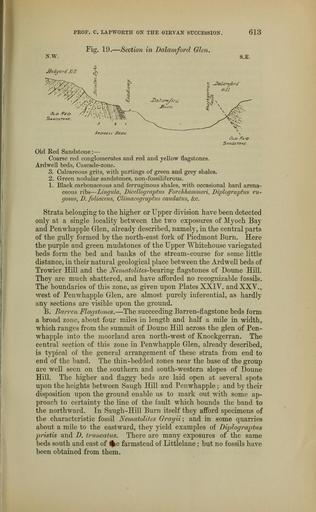MAKE A MEME
View Large Image

| View Original: | The_Quarterly_journal_of_the_Geological_Society_of_London_(13860052655).jpg (1285x2080) | |||
| Download: | Original | Medium | Small | Thumb |
| Courtesy of: | commons.wikimedia.org | More Like This | ||
| Keywords: The Quarterly journal of the Geological Society of London (13860052655).jpg PROF C LAP WORTH ON THE OTRVAN SUCCESSION <br> 613 <br> i\ W <br> Fig 19 ” Section in Ddlamford Glen <br> Mi <br> 0l o ffeo <br> Sandstone <br> A row£ i i £eds <br> Old Eed Sandstone ” <br> Coarse red conglomerates and red and yellow flagstones <br> Ardwell beds Cascade-zone <br> 3 Calcareous grits with partings of green and grey shales <br> 2 Green nodular sandstones non-fossiliferous <br> 1 Black carbonaceous and ferruginous shales with occasional hard arena- <br> ceous ribs ” Lingula Dicellograptus Forchhammeri Dijilograptus ru- <br> gosus D foliaceus Climacograptus caudatus c <br> Strata belonging to the higher or Upper division have been detected <br> only at a single locality between the two exposures of Myoch Bay <br> and Penwhapple Glen already described namely in the central parts <br> of the gully formed by the north-east fork of Piedmont Burn Here <br> the purple and green mudstones of the Upper Whitehouse variegated <br> beds form the bed and banks of the stream-course for some little <br> distance in their natural geological place between the Ardwell beds of <br> Trowier Hill and the JS'ematolites-heaTmg flagstones of Doune Hill <br> They are much shattered and have afforded no recognizable fossils <br> The boundaries of this zone as given upon Plates XXIV andXXY <br> west of Penwhapple Glen are almost purely inferential as hardly <br> any sections are visible upon the ground <br> B Barren Flagstones ” The succeeding Barren-flagstone beds form <br> a broad zone about four miles in length and half a mile in width <br> which ranges from the summit of Doune Hill across the glen of Pen- <br> whapple into the moorland area north-west of Knockgerran The <br> central section of this zone in Penwhapple Glen already described <br> is typical of the general arrangement of these strata from end to <br> end of the band The thin-bedded zones near the base of the group <br> are well seen on the southern and south-western slopes of Doune <br> Hill The higher and flaggy beds are laid open at several spots <br> upon the heights between Saugh Hill and Penwhapple ; and by their <br> disposition upon the ground enable us to mark out with some ap- <br> proach to certainty the line of the fault which bounds the band to <br> the northward In Saugh-Hill Burn itself they afford specimens of <br> the characteristic fossil Nematolites Grayii; and in some quarries <br> about a mile to the eastward they yield examples of Diplograptus <br> pristis and D truncatus There are many exposures of the same <br> beds south and east of e farmstead of Littlelane ; but no fossils have <br> been obtained from them 36936442 113692 51125 Page 613 Text 38 http //www biodiversitylibrary org/page/36936442 1882 Geological Society of London NameFound Climacograptus caudatus NameConfirmed Climacograptus caudatus NameBankID 6599587 NameFound Dicellograptus NameConfirmed Dicellograptus NameBankID 4139750 NameFound Dicellograptus foliaceus NameConfirmed Dicellograptus foliaceus NameFound Diplograptus pristis NameConfirmed Diplograptus pristis NameFound Diplograptus truncatus NameConfirmed Diplograptus truncatus NameFound Lingula NameConfirmed Lingula EOLID 11118945 NameBankID 2765654 NameFound Nematolites NameConfirmed Nematolites NameBankID 4928149 Biodiversity Heritage Library The Quarterly journal of the Geological Society of London v 38 1882 Geology Periodicals Smithsonian Libraries bhl page 36936442 dc identifier http //biodiversitylibrary org/page/36936442 smithsonian libraries Information field Flickr posted date ISOdate 2014-04-15 Check categories 2015 August 26 CC-BY-2 0 BioDivLibrary https //flickr com/photos/61021753 N02/13860052655 2015-08-26 07 56 35 cc-by-2 0 PD-old-70-1923 The Quarterly journal of the Geological Society of London 1882 Photos uploaded from Flickr by Fæ using a script | ||||